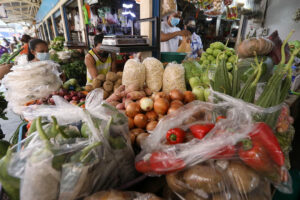Agri output may have rebounded in 2022

By Luisa Maria Jacinta C. Jocson, Reporter
THE PHILIPPINES’ overall agricultural output likely saw growth in 2022 amid strong demand and consumption as the economy reopened.
“The whole year 2022 for agriculture (could be) a positive growth close to 1% to 1.25%,” retired Pampanga State Agricultural University professor Roy S. Kempis said in a Viber message.
United Broiler Raisers Association (UBRA) President Elias Jose M. Inciong said in a Telegram message that the agriculture sector likely expanded in 2022, as mobility restrictions were lifted.
The Department of Agriculture (DA) targeted 1.2% to 1.5% agricultural output growth in 2022, after output contracted by 1.7% in 2021 which was the steepest annual contraction on record since 2001.
In the third quarter of 2022, the value of production in agriculture and fisheries at constant 2018 prices grew by 1.8%. This brought the nine-month average to 0.3%.
Agriculture contributes about a tenth to the country’s gross domestic product (GDP) and a fourth of jobs.
Mr. Kempis said producers were able to anticipate the surge in demand for food as the economy reopened.
“The farmers, traders, and processors (were able) to foresee the prospects for their livelihood and products as the Philippine economy opened and came out of the lockdowns… They were able to prepare their farms, and firms produced more once again in time for face-to-face classes and holiday season from September to December,” he added.
Mr. Kempis also noted there was increased food consumption amid “revenge spending” by Filipinos and the holiday season.
Among the sectors, Mr. Inciong said that rice production likely shrank in 2022.
“The data on it has been perplexing in recent years. Record-high harvest is reported but this is contradicted by the price of its main by-product which is rice bran. Given the high costs of fertilizers, typhoons, and unabated importation, a contraction can be reasonably expected,” he said.
Last year, the country was hit by several typhoons, which caused billions of pesos worth of agricultural damage. This led to supply chain and production disruptions.
For instance, agricultural damage caused by Typhoon Paeng (international name: Nalgae), which made landfall in November, reached P6.4 billion. The typhoon affected around 147,000 farmers and fisherfolk.
“For corn, it is the same as rice, but it should be noted that even with the reduced tariffs under Executive Order (EO) No. 171, international corn is still more expensive than local corn,” Mr. Inciong said.
In December, President Ferdinand R. Marcos, Jr. approved the extension of EO No. 171, which reduced the Most Favored Nation (MFN) tariff rates on swine meat, corn and rice, until Dec. 31, 2023.
Rice tariffs will be kept at 35% for in-quota imports and 50% for out-quota imports while corn tariff rates will be lowered to 5% from 35% for in-quota and 15% from 50% for out-quota.
Mr. Inciong said the extension of the lower tariff rates may discourage local production, citing the absence of domestic support and subsidies for fertilizers, seeds, and logistics assistance.
On the other hand, Mr. Inciong said livestock production may have registered some growth in 2022.
“For hog, there should be some growth given that local production is starting from a low base,” Mr. Inciong said. “For broilers, the normal growth rate for the sector is about 4-5%. That may be possible for 2022.”
For Federation of Free Farmers national manager Raul Q. Montemayor, agricultural output likely contracted in the fourth quarter and on an annual basis.
“Major factors would be high fertilizer, labor, fuel and input prices, erratic farmgate prices due to smuggling and excessive imports, and no significant changes in DA programs and policies,” he said in a Viber message.
Year-to-date total adjustments to fuel prices stood at net increases of P14.90 per liter for gasoline, P27.30 for diesel, and P21.30 for kerosene.
Also, prices of agricultural commodities continued to rise, driving inflation to a 14-year high of 8.1% in December. For the full year, inflation accelerated to 5.8%.
In December alone, food inflation quickened to 10.6% in December, from 10.3% in November and 1.6% a year ago, as vegetable prices skyrocketed amid supply shortages due to typhoon damage. Vegetable inflation surged 32.4% in December (from 25.8% in November), the highest since the 44% print in February 1999.
“While this (high inflation) is bad for consumption and buying, production and supply of agricultural and food products benefit from elevated prices because the value of their produce also goes up… These higher values contribute to higher values of agriculture and food production as well,” Mr. Kempis said.
The Philippine Statistics Authority is set to release its fourth-quarter and full-year estimate for agricultural output on Jan. 25.



